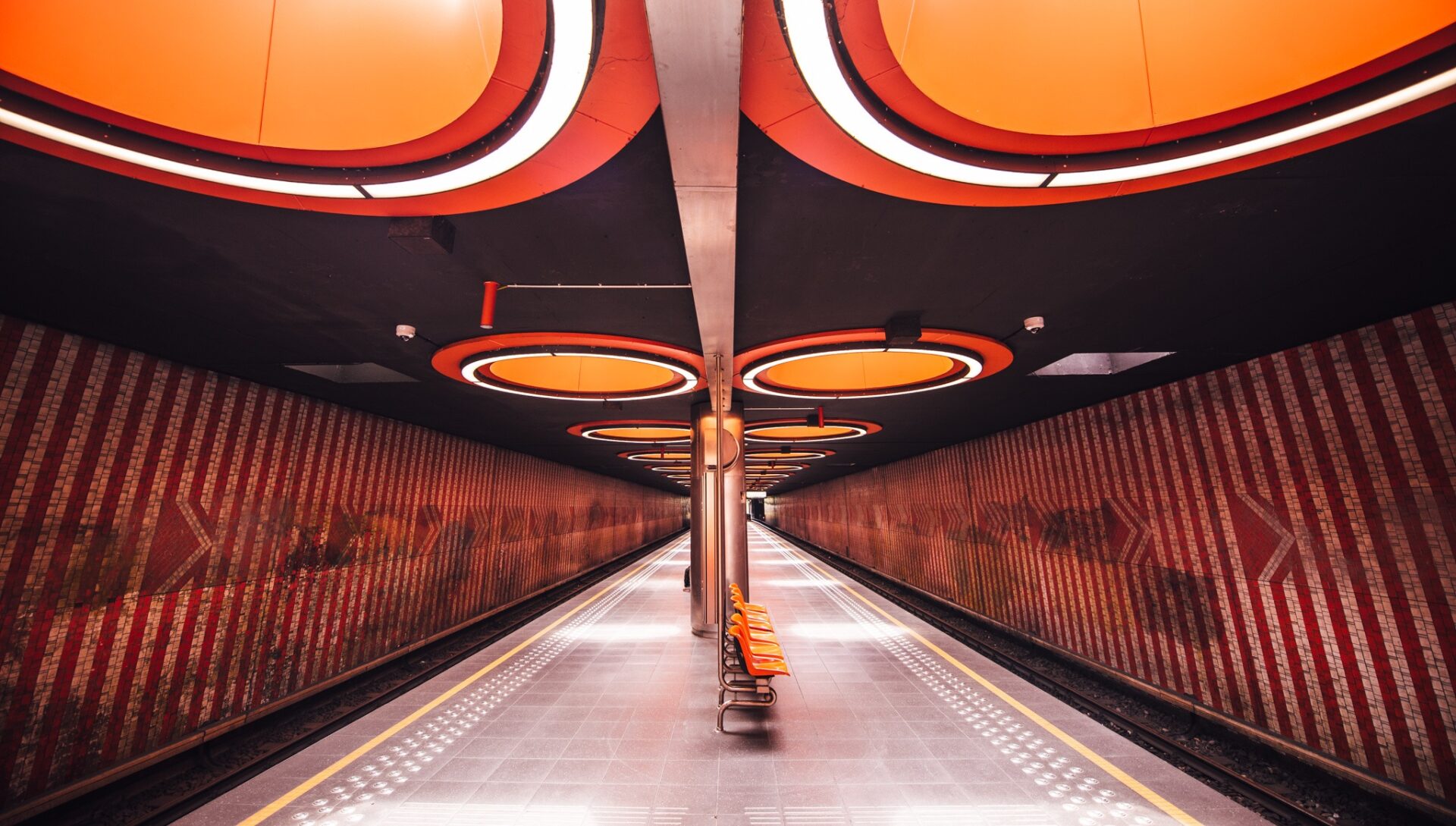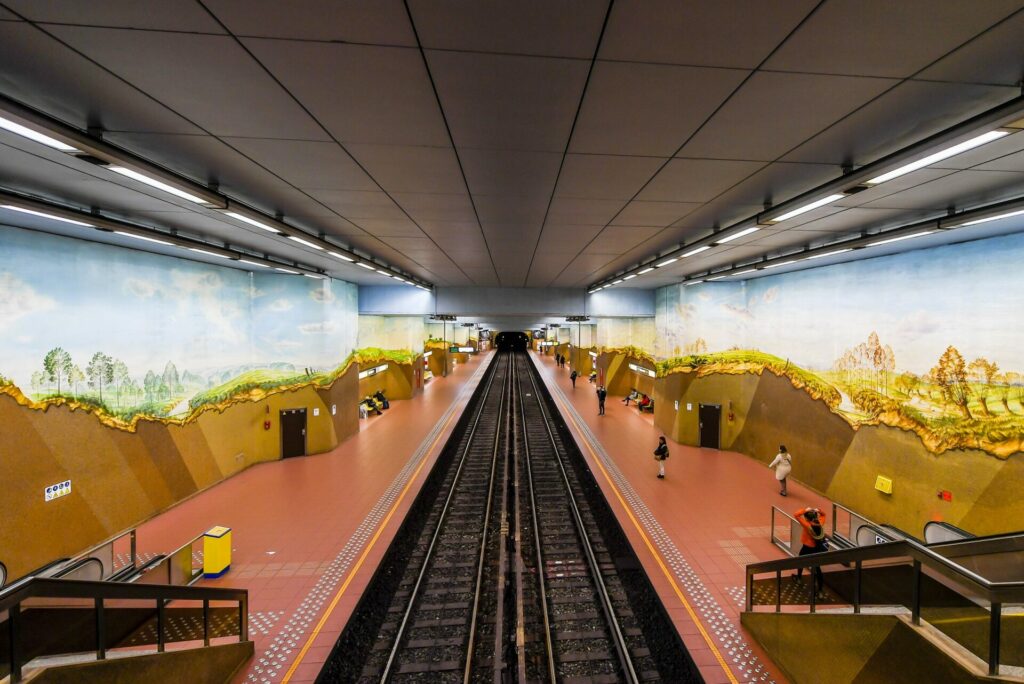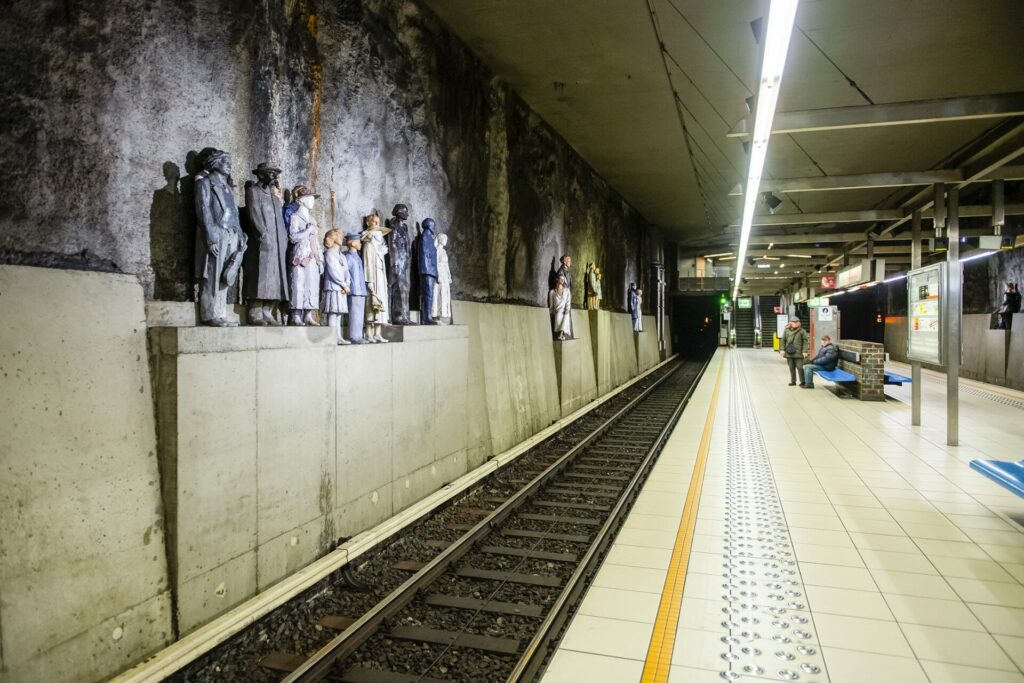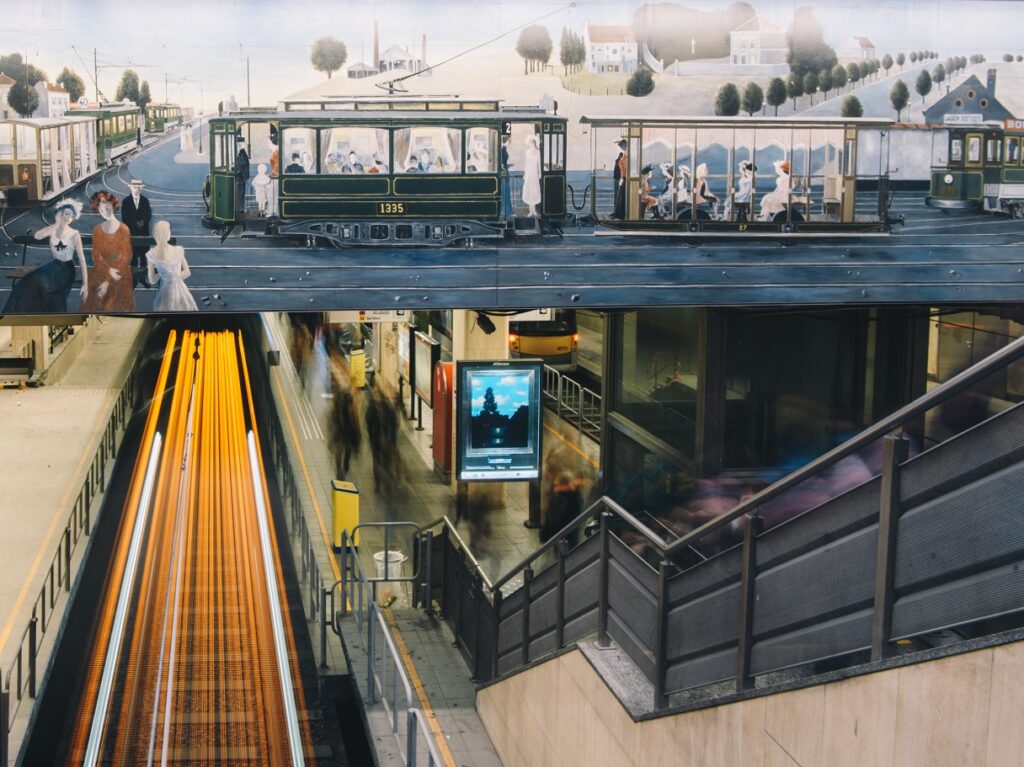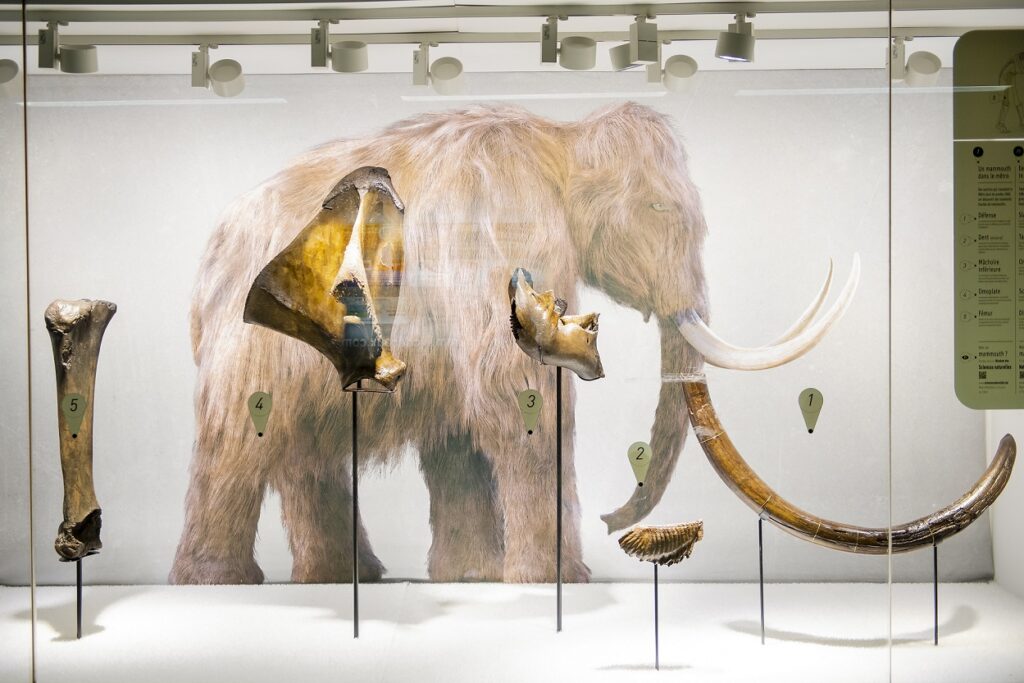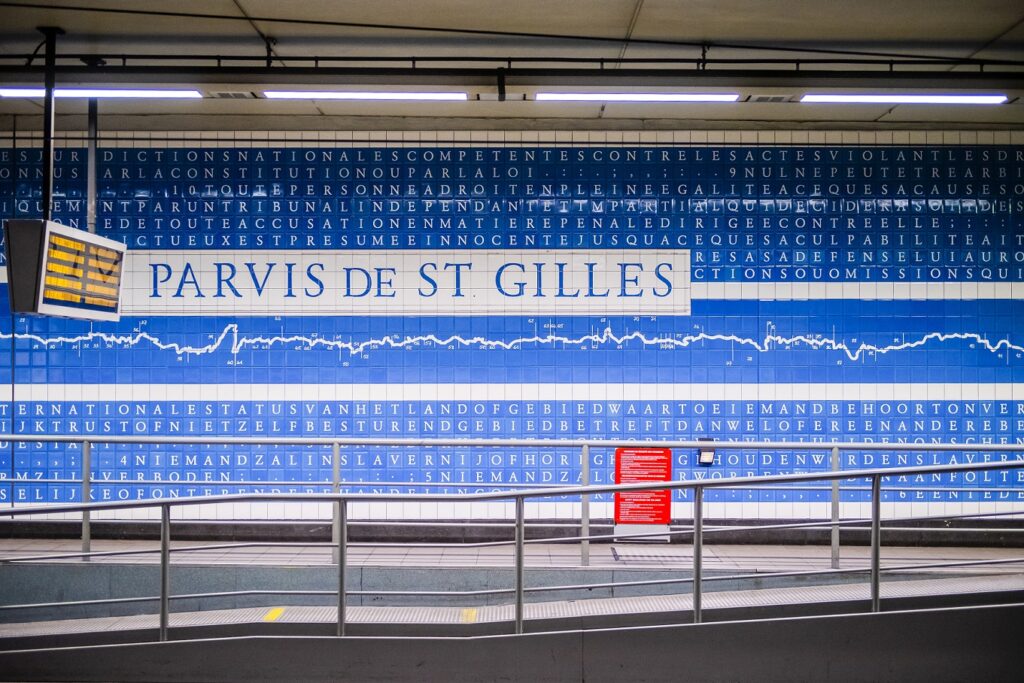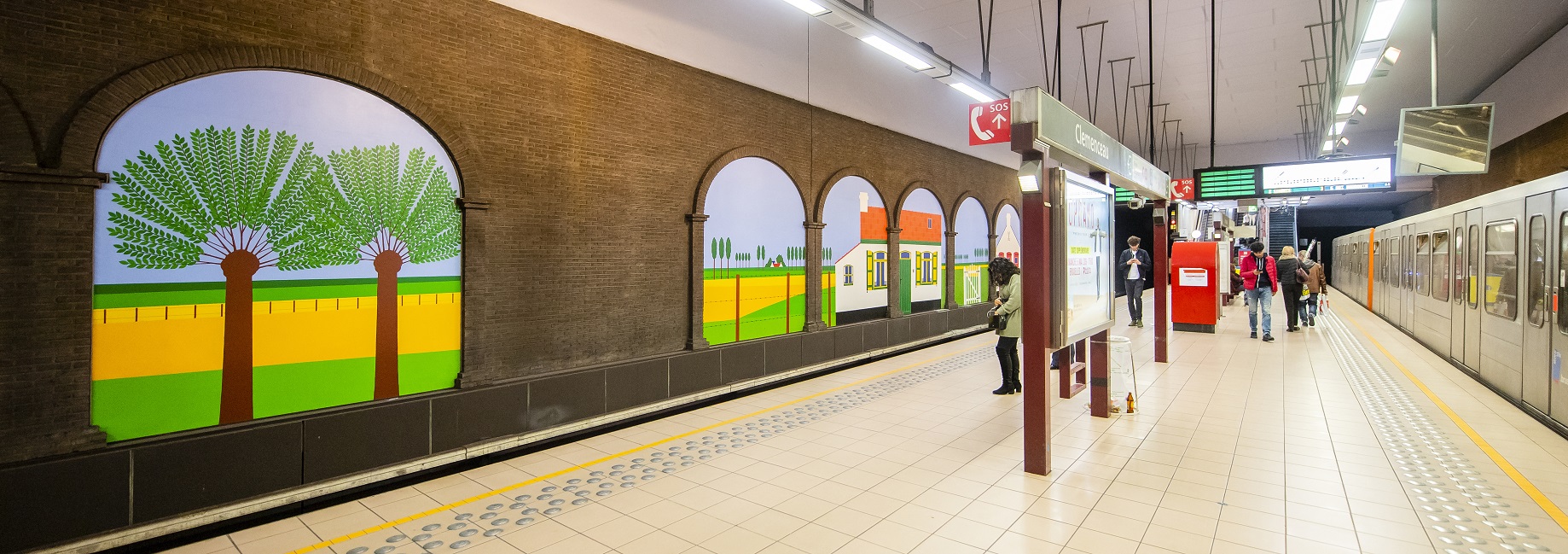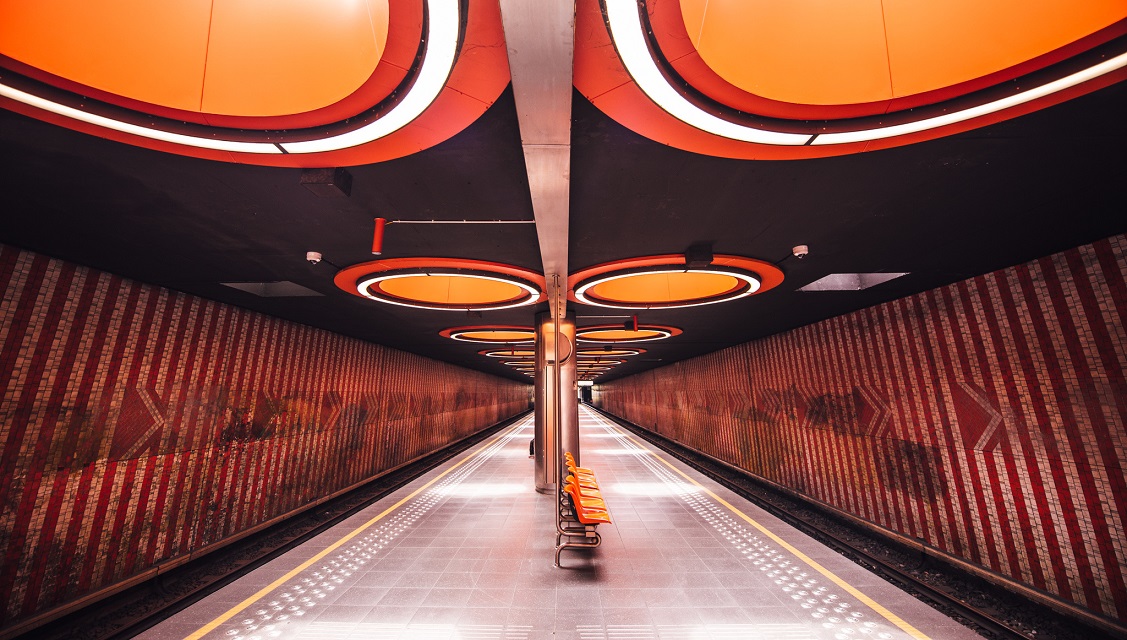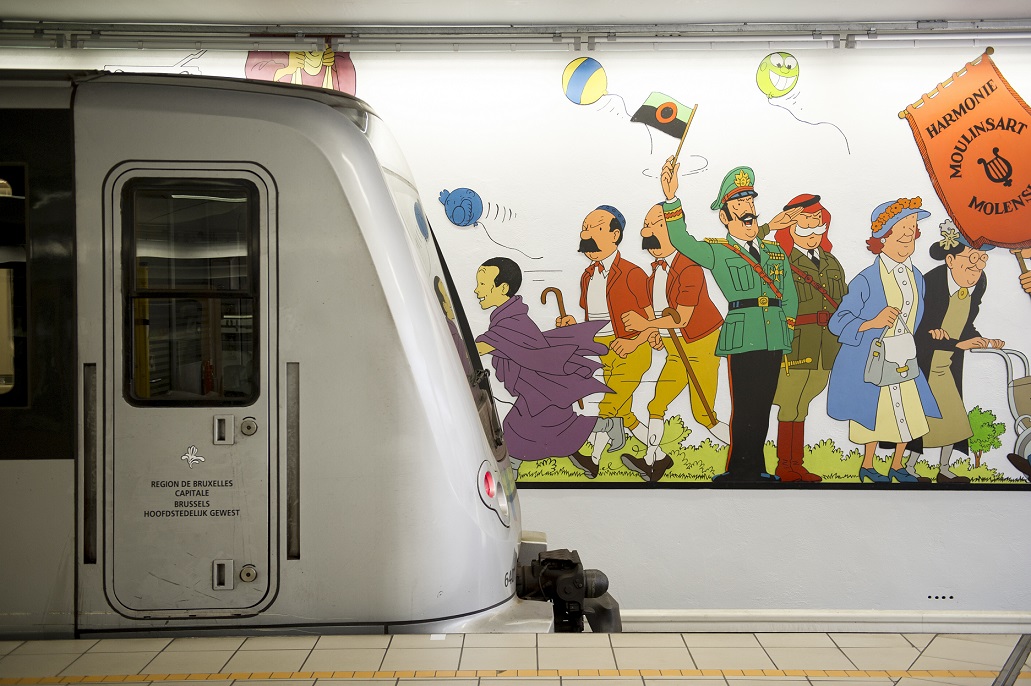When the Brussels metro was being planned and built in the 1960s, the authorities thought carefully about the visual aspects of the system. The original plan called for no advertising (except for travel posters of Belgium), major surfaces exclusively in stainless steel and marble, and site specific art in all the stations. The advertising ban eventually gave way to economic forces, but the art component was well established and has constantly grown to the current total of over 90 works of art in the now 69 stations.
From the beginning the designers wanted the underground to be "an open, lively and original environment, where Art needed a place." They wanted each station to have its own identity, representing its design or the materials used in its construction. At the same time there would be a certain consistency in the components (such as the steel and marble) that would visually tie the network together.
The works were originally selected by a three-member Artistic Committee, responsible for recommending artists and monitoring the projects and their implementation. Since 2015 the 12 member Art & Architecture Unit, part of the Brussels Regional Administration has been responsible for promoting, selecting, installing and maintaining the works of art. This included getting the necessary permits, negotiating the contracts, assisting the artists and renovating the work, when needed.
Obviously, the stations were not solely designed as showplaces for displaying art. The artists have had to adapt their projects to the constraints imposed by the engineers and architects – though the latter have also been very mindful of keeping a solution-finding dialogue open.
The artists represent different art movements and the media used include ceramics, oil paint, acrylic paint, enamelled steel, copper, stained glass, wood and resin. While some works dominate stations, others just add a touch.
Here are the stations that best represent metro art:
Vandervelde
We begin with the monumental work of hyperrealist painter Paul de Gobert (born 1949). Using trompe l’oeil and a meticulous, painstaking attention to detail, he recreates the bucolic landscape that was the Woluwe valley (where the station is located) before urbanization. The painting covers most of the surfaces of the station but for the bottom six feet or so of the walls which are covered in yellow, ochre and brown ceramic mosaics that symbolize the geological substrata. The blues and greens that predominate in the painting produce a soothing, peaceful atmosphere. Gobert painted the entire work himself, by hand.
Stuyvenbergh
Artist Yves Bosquet (b.1939) normally uses living models to sculpt his statues, but in this case, he created the 25 terracotta statues from photos. The statues represent different eras in the life of Queen Elizabeth (King Philippe’s great grandmother), including her friendships with people such as Emile Verhaeren and Albert Einstein. The walls of the station are in a completely raw and rough state, a total contrast to the minutely detailed enamelled statues.
Alma

Alma, 1982
Here an artist is not adding his or her work to an already completed station, rather the art is integral to the station and creates a complete world. Designed by architect Lucien Kroll (1927-2022), and painter Simone Kroll (b.1928), the supporting columns are trees, the ceiling is reminiscent of autumn leaves, and the walls are completely tiled in complementary colours. An homage to visionary architect Antoni Gaudí, this is the only metro station in Brussels that is a protected landmark.
Aumale
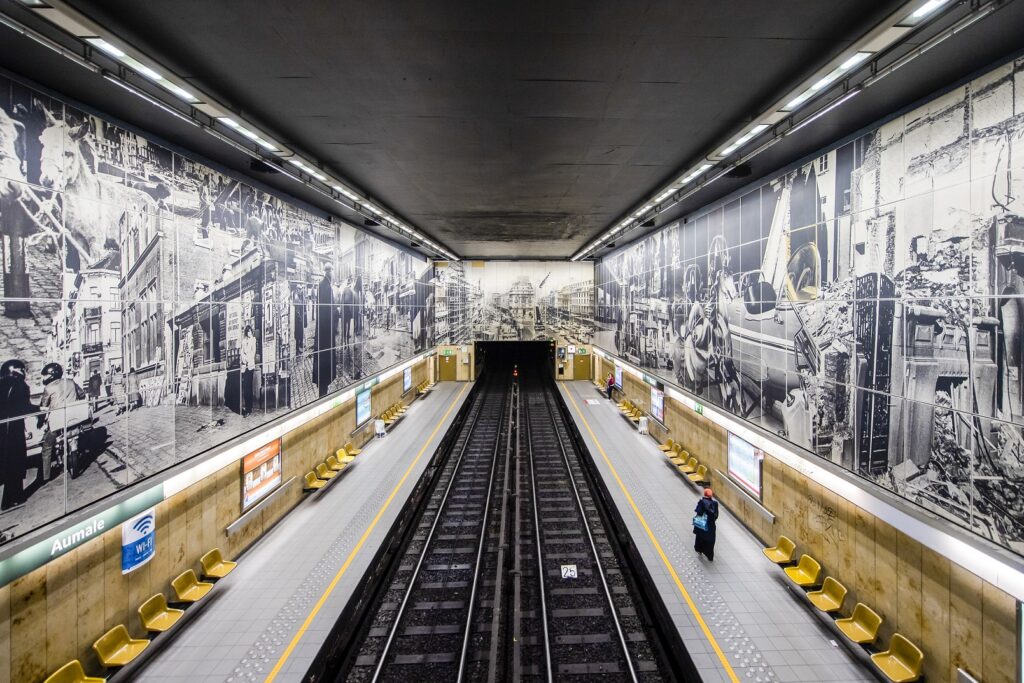
Metrorama 78, 1982
Artist Jean-Paul Laenen (1931-2012) worked with members of the STIB Photo Club to create a 600 square metre photographic mural that covers the station, on one side, with photos chronicling the building of the station (workers, bulldozers, the levelling of structures), and on the other side, photos that reflect the history of the neighbourhood (cafés, a horse market, old houses and stores).
Montgomery

Magic City, 1976
Belgium’s Jean-Michel Folon was already globally renowned when he was commissioned to do his magic on 150 square metres of concrete wall at the gates of the Montgomery Station. As he stood looking at the wall deciding what to do, rays of sunlight shone through a hole in the roof and made him realize that this is something one never sees in the underground. The idea of a picture of a radiant sun shining on a magical city was born – making it particularly ironic that the mural is now in danger from the elements and solutions are not apparent. It is in poor condition, suffering from internal pollution and, above all, damage linked to water infiltration. And as it is permanently attached to the concrete wall, it cannot be removed to protect it during the station’s forthcoming renovation between 2026 and 2031.
Bourse
The Bourse Station was one of the first stations built and boasted works of art by two of the most celebrated Belgian artists of the 20th century: a painting by Paul Delvaux (1897-1994) and a kinetic sculpture by Pol Bury (1922-2005). In 2019 the station was completely redone. The two existing works of art were restored, and two new works were added, but what we are highlighting is the fifth work of art in the station, the Espace Qartier, the first metro cultural space dedicated to contemporary art and culture. Designed by architect Gordana Micic, the gallery is made from natural stone, projectors, LED screens and a suspended ceiling that uses lighting to show the constellations seen from Earth. Different cultural organizations take over the space for a minimum of three exhibitions per year, featuring local emerging artists.
The other two pieces are Portraits of Cyclists (2019) by An MarieVan Gusegem (printing on enamelled steel plates), and Tour of Belgium (2019) by Gordana Micic.
Gare du Midi
When grading work was being done for the Gare du Midi metro station in the 1980s, the 30,000-year-old bones of prehistoric animals (mammoths, deer, bison, etc) were uncovered. The STIB, in partnership with the Museum of Natural Sciences, displayed them in the station. The display was completely renovated five years ago with new lighting and a detailed scenography, which maximizes the artistic elements of the display. While you’re here see if you can find the other two works of art that grace the station, one by Jacques Moeschal (1913-2004) (Oil painting) and the other by Jacques Bage (b. 1942).
Parvis de Saint-Gilles
Artist Françoise Schein (b.1953) has celebrated the Universal Declaration of Human Rights and brought it to the public’s attention with metro design in Paris, Brussels, Lisbon, Haifa, Stockholm, London and Berlin. In the Saint-Gilles station she has covered the walls in blue and white enamelled tiles. The tiles are divided into two groups; in one group the complete text of the declaration appears, one letter per tile. The other represents the borders of the European countries laid end to end, as she explains “this evokes the relation between the European borders and human rights.”
Clemenceau
Artist Joseph Willaert (1936-2014) uses such bright colours and simple shapes that one might think his work is done with stencils. In the Clemenceau station he has recreated a rural past that glides by the train’s windows, all the elements of that world lined up one after the other in separate panels to evoke nostalgia for simpler, less material times. See if you can spot the anomaly in the work.
Belgica
In 2009 Belgium inaugurated the first 100% autonomous polar base in Antarctica, the Princess Elizabeth Station. To underline the role played by public transport in fighting climate change, the STIB used this event to work with the International Polar Foundation to create a graphic work at the Belgica Station. Graphic artists Thierry Verbeeck (b.1981) and Cédric Bougeaux (b.1980) designed two murals each 2.40 metres high and 92 metres long that take us from the Belgian Antarctic expeditions led by Adrien de Gerlache in 1897 on the vessel Belgica to the latest in climate change research.
On the way into the station, you will walk under a multi-coloured arch of enamelled steel by artist Camiel Van Breedam (b.1936).
Erasme
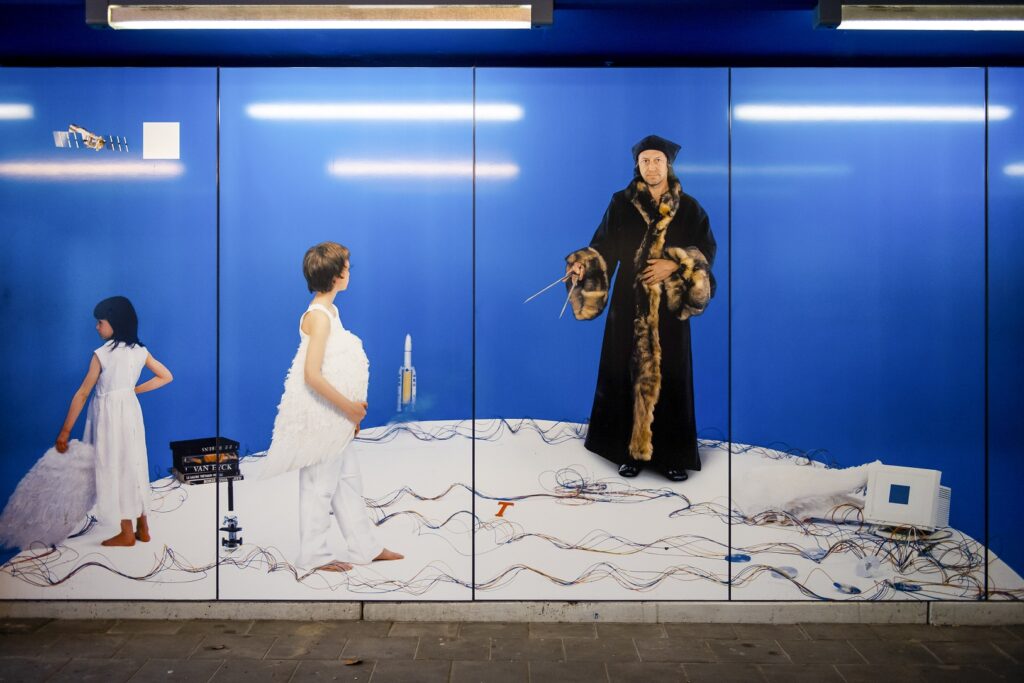
Festina Lente 2003
The artwork by Michel Mouffe (b.1957) highlights the pacifism of Erasmus, his attachment to education and his travels across a Europe of philosophers. There are illustrations and photographic compositions as well as many examples of Erasmus’ sayings. Some 184 square metres of ceramic tiles are laser etched with the proverbs; 49 of the tiles are decorated with hand painted motifs. 350 square metres of glazed enamelled steel are silkscreen printed with computer images. The blue colour that predominates on the tiles took 18 months to develop, and it took three years for the project to be completed.
Pannenhuis
So small that it has only one entrance, Pannenhuis is in a bit of a byway neighbourhood and normally would not attract any attention. However, it has become an Instagram sensation and a location for fashion shoots. The reason is that the ceilings of the entrance and the sole escalator/staircase down into the station are copiously hung with bright red and orange clusters of lights and sculptures that evoke a science fiction vibe of the 1970s.
Stockel
Shortly before his death, Hergé (1907-1983) made the preliminary sketches for the two bas-reliefs, each 135 metres longs that include 140 characters taken from 22 of the Tintin books. These full-scale images are juxtaposed to create humorous and unexpected situations. The Hergé Studios completed the images in studio before affixing them to the station walls.
Delta
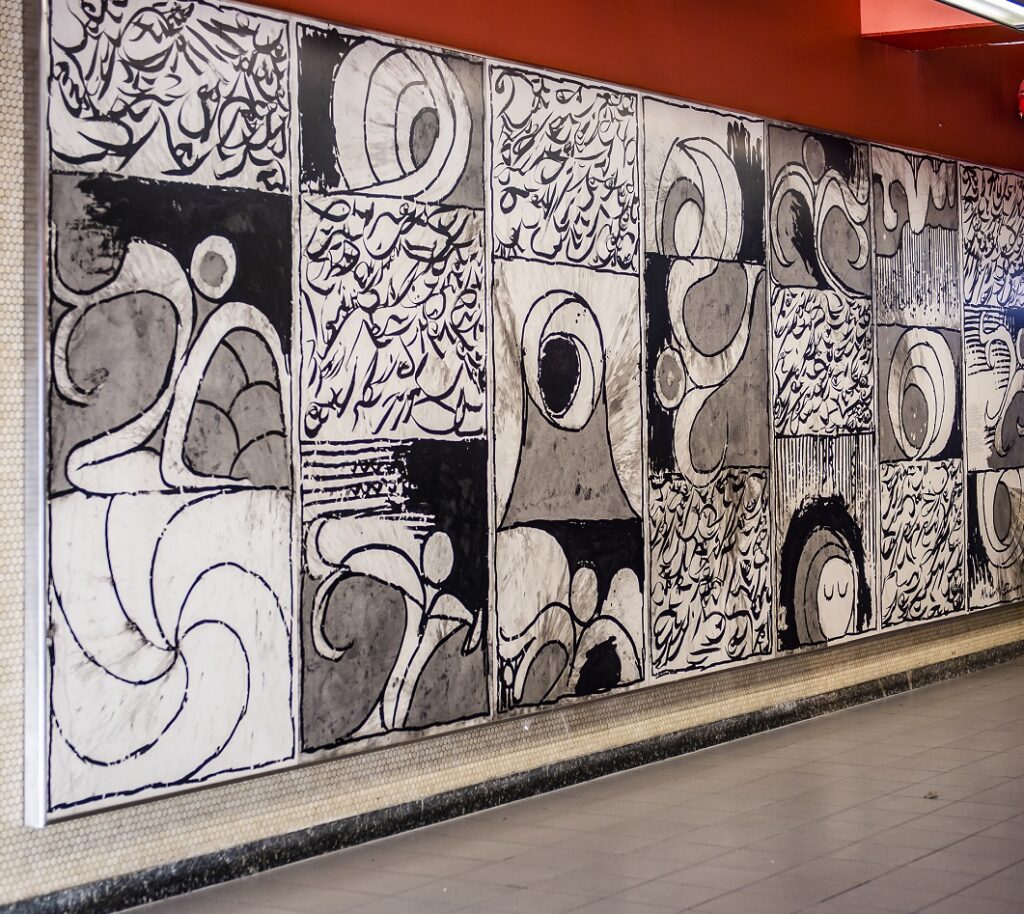
Sept Ecritures, 2006
A combination of the works of Pierre Alechinsky (b.1927) and Christian Dotrement (1922-1979), both members of COBRA (COpenhagen BRussels Amsterdam – a post WWII art movement), the piece consists of seven panels each divided into three sections. Two of the sections are images by Alechinsky and the third section being Dotremont’s poetry executed in his personal calligraphy. The themes are the wheel and shelter.
India ink on paper pressed on wood and synthetic resin.
Outside there is a piece by Jan van den Abbeel (1943-2018) of geometric brightly coloured glasal cladding.
Anneessens
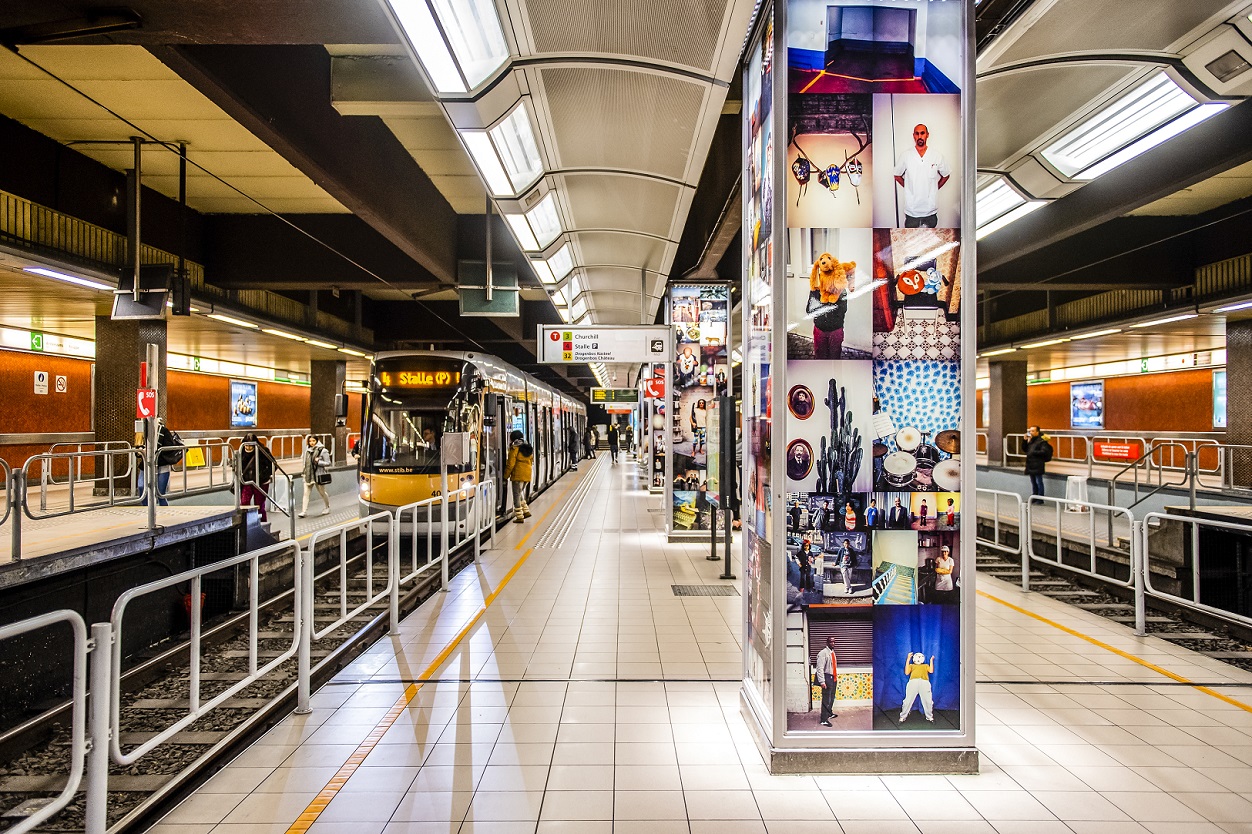
Casting, 2007
To create this work of art that covers the eleven central columns of the station, artist Vincen Beeckmen (b.1973) distributed and posted a notice to the people living in the neighbourhood to apprise them of the project and get them involved. The columns are covered in large and small photos of the inhabitants, as well as local hangouts and assorted animals and objects, giving a homey feeling to the station.
Ribaucourt

Le feu de Néron – La Bataille des Stylites, 1988
Artist Fernand Flausch (1948-2013) created two upper friezes of 60 metres each facing each other across the tracks that are very different from each other. Both have comic strip elements, but in one we have a story that is led by human characters and their environment, as well as architectural elements in bright yellow and red. The other consists of collage and the use of negative space in dark tones.
Lemonnier
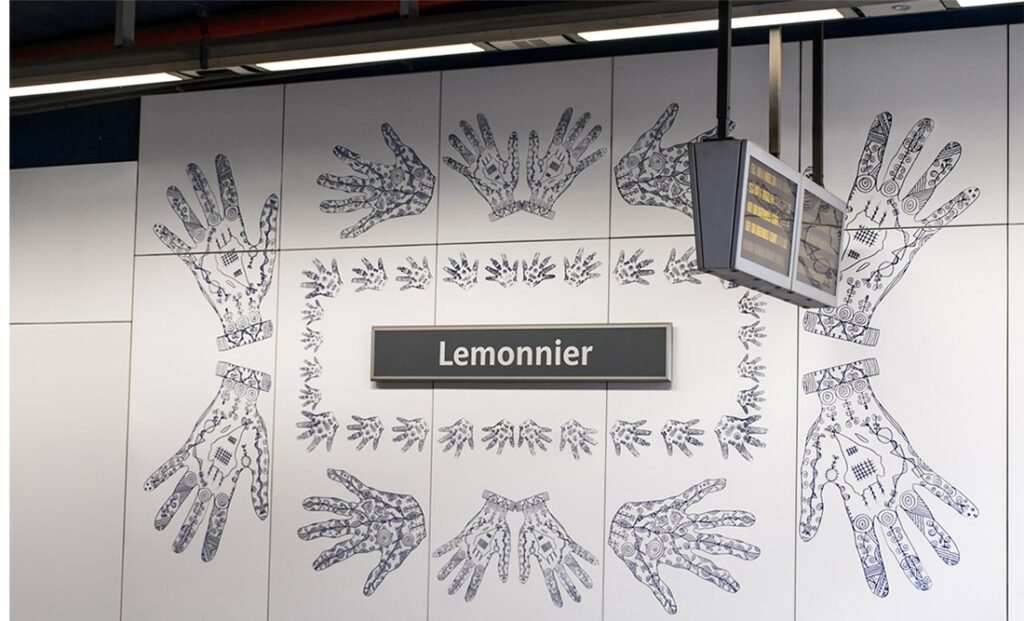
Les Mains de l’Espoir
Starting in 1994, artist Hamsi Boubeker (b.1952) collected the imprints of hands from 87 countries; most were gotten in schools, but there are Nobel Peace Prize winners, such as Yasser Arafat and Adolfo Perez Esqivel, as well as personalities from the worlds of literature, sports, cinema, art, religion. There are also imprints from prisoners, the homeless, asylum seekers and refugees. For the artist, an open hand is the symbol of peace, friendship, openness and tolerance. The imprints were decorated with traditional tattoos and enlarged to decorate the walls of the station.
Arts-Loi
These striking black and white photographs celebrate the night crews who worked on the complete renovation of this important metro crossroads. The artist photographer Jeroen de Vlaminck is particularly in tune with the subject having performed that line of work himself.
There are two other works of art in the station, one by Jean Rets (1910-1998) (Enamelled ceramic tiles) and one by Gilbert Decock (1928-2007) (Bas-relief on varnished wood).
Beekkant
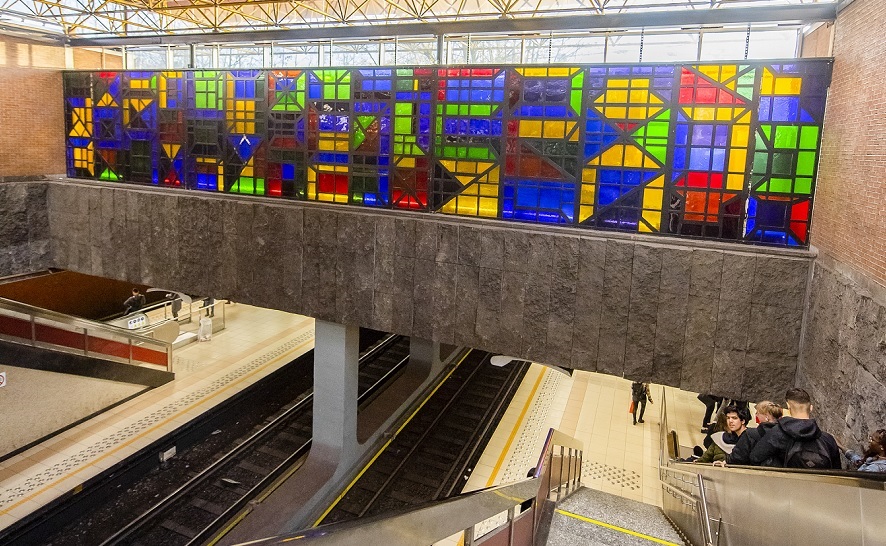
Compositie, 2011
Abstract artist Guy Vandenbranden’s (1926-2014) piece is an essential part of the wall, as well as a lighting element and its forms echo the metallic structure of the roof. The geometric shapes and colours connected by black borders of varying thicknesses repeat but also maintain a balance between the forms and the colours.
Eddy Merckx
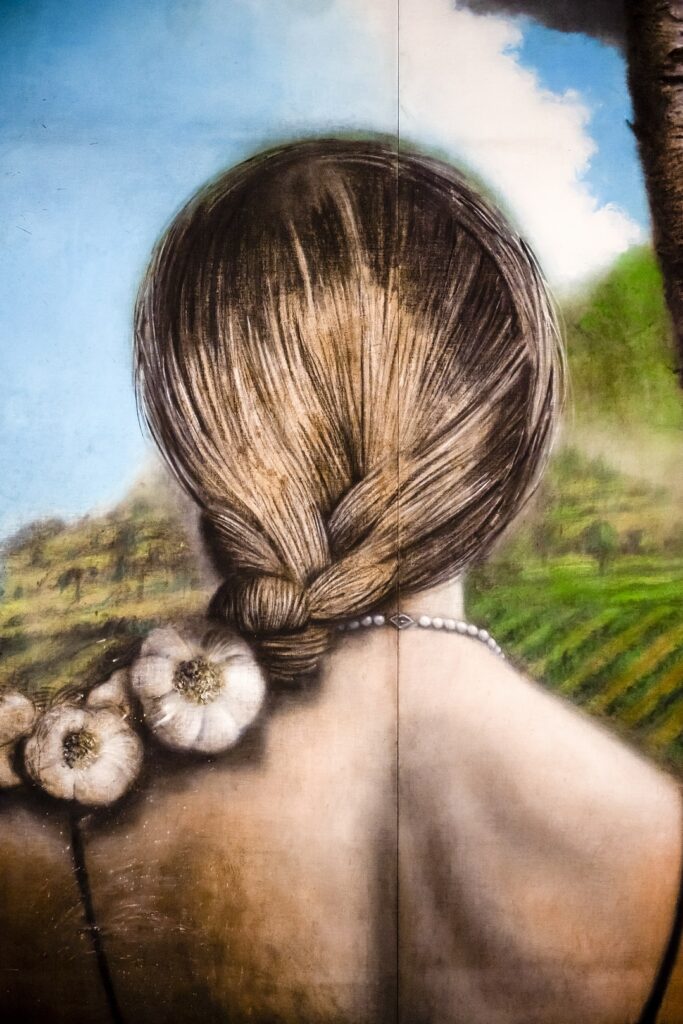
Le Cheval d’Octobre, 2003
Artist Camille De Taeye (1938-2013) said that the spirit of his work was in allusions, provocative allusions to the forbidden, which get to the heart of things and allow many different interpretations. This is certainly true of the dreamlike paintings he did for this station for which he took previously drawn sketches that he reworked to produce a tight narrative.
The art is framed by fabric made with stainless steel wires, which took a year to create.
CERIA/COOVI

Interurban, 2003
Artist Marin Kasimir (born 1957) uses the panorama technique: the photos were taken with a rotating camera which turns on its axis. This ‘roundshot’ camera increases the shot time to 20 minutes per round and can increase its field of vision up to 360°. The two photos he chose for his panorama are in very different places, one is the CERIA/COOVI and the other is the Place de la Monnaie in central Brussels. And the time frame is different too, the CERIA/COOVI picture shows the four seasons, the Monnaie picture shows the rhythm of one afternoon. This technique, seemingly a combination of mural painting, photography, movies and architecture, envelops the viewer completely.
Schuman
Schuman is both a Metro station and a SNCB train station. In a complicated engineering feat, the station was redesigned eight years ago, so that the SNCB tracks hang at an angle way above the Metro tracks in two bridges. Artist Pieter Vermeersch (born 1973) has used the three primary colours red, yellow and blue to paint the undersides of the bridges. Each area between two pillars gradually changes colour, from white to 100% saturated colour. In the wells above the escalators that connect the SNCB train station and the Metro station, he has used photographs that he took of the sky to create his mural, the colours of which evolve from stormy sky to milky sunshine.
There is also a frieze (2019), which is a collaborative wok between a Doctor of Philosophy and Social Sciences, Philippe Van Parijs, and graphic artist, Calogero Belluzzo.
STIB/MIVB offers a free downloadable brochure ‘When Art takes the Metro’, which is also available in paper form at Standard Boekhandel on Boulevard Anspach and at the Tram Museum for €5.

